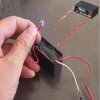Futterama
Member
Hi forum,
I have a few of these high voltage generator modules from ebay, search for "DC 3V to 7KV 7000V Boost Step-up Power Module High-voltage Generator" on ebay if you want to see more than the attached picture. I'm going to use it for creating a strong spark for igniting propane, like in a spud gun.
I'm trying to control it using a PIC microcontroller, but the module seems to generate so much electrical noise that it will reset the PIC even when the two are not electrically connected, but the PIC is just sitting on the same breadboard where I also put a MOSFET and battery connector to drive the HV module.
I'm driving the module from a dedicated LiPo cell so that the power for the module is separate from the rest of my system. I used a TO-220 N-channel MOSFET for switching the module on/off and I even added an optocoupler so the PIC could be electrically separate from the module.
How can I make the PIC turn the module on/off in a reliable way? I'm going to have other electronics (RC servos and a receiver) near this module so I cannot have it interfere with everything around it.
Are there any general rules about HV I need to consider? Like keeping the HV wires short? Maybe even shield them? Keeping the supply wires from the battery to HV module short and then have longer wires from PIC to optocoupler?
I have also considered using one of those modules used to generate the spark plug voltage in gasoline powered RC planes, but those modules are far more expensive, bigger and heavier, but I guess they don't interfere too much with other electronics since they work in RC planes. I would like to archive the same with these cheaper modules if possible.
Thanks.
EDIT: I have also attached a scope shot of the battery supply wires with the HV module powered.
I have a few of these high voltage generator modules from ebay, search for "DC 3V to 7KV 7000V Boost Step-up Power Module High-voltage Generator" on ebay if you want to see more than the attached picture. I'm going to use it for creating a strong spark for igniting propane, like in a spud gun.
I'm trying to control it using a PIC microcontroller, but the module seems to generate so much electrical noise that it will reset the PIC even when the two are not electrically connected, but the PIC is just sitting on the same breadboard where I also put a MOSFET and battery connector to drive the HV module.
I'm driving the module from a dedicated LiPo cell so that the power for the module is separate from the rest of my system. I used a TO-220 N-channel MOSFET for switching the module on/off and I even added an optocoupler so the PIC could be electrically separate from the module.
How can I make the PIC turn the module on/off in a reliable way? I'm going to have other electronics (RC servos and a receiver) near this module so I cannot have it interfere with everything around it.
Are there any general rules about HV I need to consider? Like keeping the HV wires short? Maybe even shield them? Keeping the supply wires from the battery to HV module short and then have longer wires from PIC to optocoupler?
I have also considered using one of those modules used to generate the spark plug voltage in gasoline powered RC planes, but those modules are far more expensive, bigger and heavier, but I guess they don't interfere too much with other electronics since they work in RC planes. I would like to archive the same with these cheaper modules if possible.
Thanks.
EDIT: I have also attached a scope shot of the battery supply wires with the HV module powered.
Attachments
Last edited:



